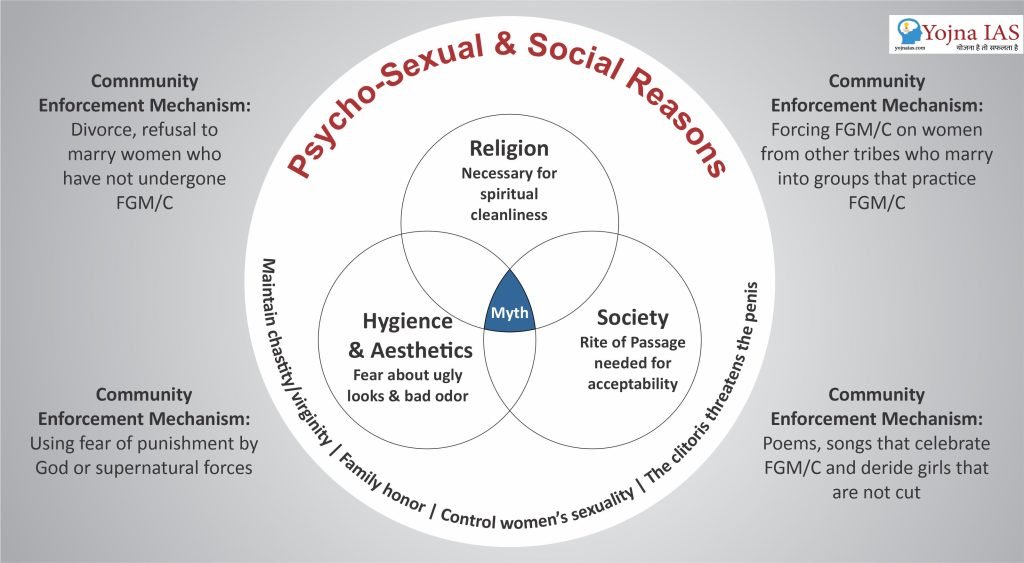16 Feb 2024 Female Genital Mutilation
This article covers ‘Daily Current Affairs’ and the topic details of ”Female Genital Mutilation”.This topic is relevant in the “Social Issues” section of the UPSC CSE exam.
Why in the News?
According to recent reports from UN agencies, around 4.4 million girls worldwide could become victims of female genital mutilation by the year 2024.
About Female Genital Mutilation
- Female Genital Mutilation (FGM) refers to procedures involving the modification or harm to female genitalia for non-medical or cultural motivations. Internationally, it is acknowledged as a violation of human rights, impacting the well-being and dignity of girls and women.
- While the majority of those subjected to FGM reside in sub-Saharan Africa and the Arab States, this practice is also observed in certain countries in Asia, Eastern Europe, and Latin America.
- The United Nations Population Fund (UNFPA) notes that despite uncertain origins, FGM appears to have predated both Christianity and Islam, with historical evidence such as Egyptian mummies displaying characteristics of the practice.
- Additionally, the ancient Greek historian Herodotus asserted that in the fifth century BC, circumcision was practiced by the Phoenicians, Hittites, and Ethiopians.
Motives Behind Female Genital Mutilation
In various regions, Female Genital Mutilation (FGM) is carried out for diverse reasons, classified by the UNFPA into five categories:
- Psycho-Sexual Reasons: FGM is employed as a means to control women’s sexuality, with the removal of genitalia, especially the clitoris, believed to curb perceived insatiable desires.
- Sociological or Cultural Reasons: Viewed as part of a girl’s initiation into womanhood and an integral aspect of a community’s cultural heritage.
- Hygiene and Aesthetic Reasons: Some communities consider external female genitalia as unattractive and unclean, prompting FGM for hygiene and aesthetic purposes.
- Religious Reasons: While not endorsed by Christianity or Islam, FGM may be justified using “supposed” religious doctrines, according to the UNFPA.
- Socio-Economic Factors: In certain communities, FGM is a prerequisite for marriage, particularly where women are economically dependent on men.
Moreover, the World Health Organization (WHO) highlights additional motives, including “ the attempt to ensure premarital virginity and the belief that FGM reduces libido, aiding in resisting extramarital sexual acts”. FGM may also be linked to cultural ideals of femininity and modesty.

Challenges in Combating Female Genital Mutilation (FGM):
- Cultural and Social Norms: FGM often finds its roots in cultural and social norms, functioning as a tradition passed down through generations within communities. The task of altering these deeply ingrained beliefs and practices proves to be a formidable challenge.
- Lack of Awareness and Education: Within communities where FGM is prevalent, there is a significant lack of understanding regarding the detrimental consequences associated with the practice. The absence of awareness and education about the physical and psychological health risks linked to FGM contributes to its perpetuation.
- Lack of Adequate Data Collection and Reporting: Efforts to address FGM are impeded by limited data collection and reporting on its prevalence. The absence of comprehensive information hinders a clear understanding of the issue’s scope and undermines the effective targeting of interventions.
Status of FGM in India
- As of right now, the nation does not have legislation outlawing the practice of FGM. The Ministry of Women and Child Development stated in 2017 that “currently there is no public information or study which proves the practice of FGM in India” in answer to a petition filed in the Supreme Court.
- However, according to some other unofficial reports, procedures of FGM are prevalent amongst the Bohra community, primarily in the states of Maharashtra, Kerala, Rajasthan, Gujarat, and Madhya Pradesh.
Global Efforts Towards Elimination:
- Since 2008, the United Nations Population Fund (UNFPA) and the United Nations Children’s Fund (UNICEF) have jointly spearheaded the most extensive global initiative dedicated to eradicating female genital mutilation (FGM).
- In 2012, the UN General Assembly officially designated February 6th as the International Day of Zero Tolerance for Female Genital Mutilation, with the overarching goal of intensifying and directing efforts toward eliminating this practice. The Theme for 2024 was “Her Voice. Her Future,”.
Download Yojna daily current affairs eng med 16th feb 2024
Prelims practice questions
Q1. Which scheme focuses on promoting the well-being of pregnant women and lactating mothers by providing them with cash incentives for better nutrition and healthcare?
A. Pradhan Mantri Surakshit Matritva Abhiyan (PMSMA)
B.Janani Suraksha Yojana (JSY)
C.Sukanya Samriddhi Yojana (SSY)
D. Beti Bachao, Beti Padhao (BBBP)
ANSWER: B
Q2. The Swadhar Greh scheme provides shelter and support to
A. Widowed women
B. Pregnant women
C. Women in distress without family support
D. Women entrepreneurs
ANSWER: C
Mains practice questions
Q1. Explore the role of cultural diversity and migration patterns in either perpetuating or challenging the practice of Female Genital Mutilation globally.
Q2. Evaluate the impact of educational initiatives and awareness programs in mitigating the prevalence of Female Genital Mutilation.
I am a content developer and have done my Post Graduation in Political Science. I have given 2 UPSC mains, 1 IB ACIO interview and have cleared UGC NET JRF too.


No Comments